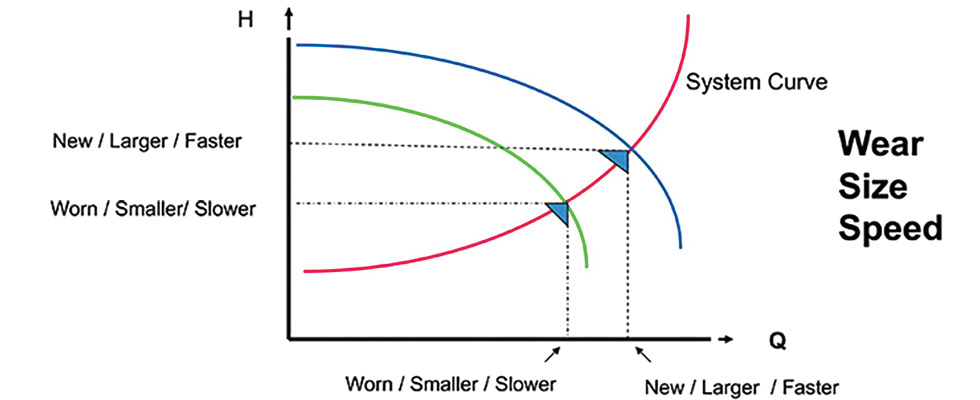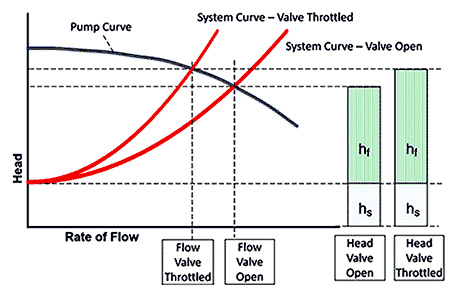
How often does a user stand in front of one of their pumps and wonder if its performance matches their expectations or the design specifications? Do they examine the tag displaying the flow rate (X gallons per minute [gpm]) and total dynamic head (TDH) (Y TDH) and think, “Does this tell the whole story?” Perhaps they have questioned whether the pump is operating according to its curve and design point or if recent system changes have been made in order to impact production.
These questions are common but not always easy to answer by just looking at the pump. The pump’s performance is driven by the interaction between its curve and the system curve. System changes—such as valve adjustments, added lines or variations from the original design—can shift the system curve and affect pump performance. Users can better understand their pump’s performance and optimize its operation by gathering key data points.

Understanding Pump Performance
To assess a pump’s true performance, start by asking the following questions:
Is the pump operating at its best efficiency point (BEP)?
o The BEP is where the pump operates most efficiently. Check if the system curve intersects with the pump’s BEP. Any deviation from this point can indicate changes in the system that affect performance. The farther from the BEP the system curve intersects the pump curve, the shorter the mean time between repairs (MTBR) will be for the pump.
Is the TDH being accurately measured?
o Use calibrated pressure gauges or transducers on the pump’s suction and discharge sides to determine differential pressure, which is essential for calculating TDH.
Are flow meters installed and documented?
o Ensure there is accurate documentation of flow rates during pump operation. Identify peak production times and check if increased flow demands align with the pump’s published curve. Operating far from the BEP can reduce the time between necessary repairs.
Has there been a change in the pump’s amp draw?
o Changes in amp draw can indicate modifications such as impeller resizing. The amp draw helps determine the pump’s position on the curve. Rebuilding the pump or changing the impeller’s size, material or vane angles will affect the performance and the accuracy of the published curve.

Maintenance & Setup Considerations
Evaluate the pump’s maintenance and setup to understand its condition:
MTBR:
o Compare the MTBR of the pump with other pumps in the system. If this pump requires more frequent repairs, it might indicate an issue with how it interacts with the system.
Parallel pump operation:
o Ensure all pumps running in parallel are identical in model, size, impeller diameter and pump curve. Differences can cause one pump to deadhead the others. If the pumps are vertical pumps, were the impeller’s lifts set at the same clearances?
o Also, if using variable frequency drives (VFDs), check that they are operating at the same percentages for all pumps to avoid similar issues.
Was the pump recently rebuilt?
o There can even be differences in the pumps if they are repaired at different intervals or the repair facility has changed any parameters inside the pump (impeller diameter, vane angles, materials of construction, etc.).
o When the pump was reinstalled, were the impeller’s clearances set properly?
The Impact of Change
System changes can significantly affect pump performance:
Valves:
o Changes in valve types or their openness alter the system curve and, consequently, pump performance.
Other equipment in the system:
o Small changes to equipment in the system, even items such as small nozzles, can make an impact on the system curve.
Fluid characteristics:
o Variations in fluid temperature, tank levels and filter setups impact TDH calculations and net positive suction head available (NPSHa).
o Are there areas in the system that a foreign object or air can get into the fluid? These can have a major impact on the pump as well as the system.
Auditory cues:
o Listen for unusual sounds like cavitation, indicating the pump needs repair and the system needs evaluation.
Making Informed Decisions
Users can build a clear picture of their pump’s performance by systematically evaluating these factors. The next time a user stands in front of their pump, they will confidently understand what it is doing and how it performs.

